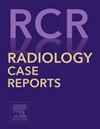颅内动脉瘤的血管内治疗:成功栓塞的分步方法
Q4 Medicine
引用次数: 0
摘要
头颈动脉瘤是头皮动静脉瘘(AVF)的一个亚型,是一种罕见的病理病变,其特征是浅表动脉和引流静脉之间的异常瘘连接,没有介入毛细血管床。我们呈报一个位于头皮的颅内动脉瘤的病例报告,在我们的三级护理中心使用经皮血管内介入注射栓塞治疗。本报告强调了复杂的血管解剖和高分流流在治疗涉及头颈部的此类病变时所带来的挑战。我们讨论了选择治疗方法的基本原理,强调了患者特定策略的重要性,以实现异常血管连接的成功闭塞。我们的经验强调了使用合适的栓塞材料经动脉和/或经静脉栓塞治疗颅内动脉瘤的有效性。本病例报告对现有关于头皮avf治疗方案的文献做出了贡献,为优化这些罕见但具有临床意义的病变的治疗结果提供了见解。本文章由计算机程序翻译,如有差异,请以英文原文为准。
Endovascular treatment of cirsoid aneurysms: A stepwise approach to successful embolization
Cirsoid aneurysms, a subtype of arteriovenous fistulas (AVF), of the scalp are rare pathological lesions characterized by abnormal fistulous connections between superficial arteries and draining veins without intervening capillary beds. We present a case report of a cirsoid aneurysm located on the scalp, treated at our tertiary care center using percutaneous endovascular intervention with injection embolics. This report highlights the challenges posed by complex vascular anatomy and high shunt flow in the treatment of such lesions involving the head and neck. We discuss the rationale for selecting the treatment approach, emphasizing the importance of a patient-specific strategy to achieve successful obliteration of the abnormal vascular connections. Our experience underscores the efficacy of transarterial and/or transvenous embolization using appropriate embolic materials in the management of cirsoid aneurysms. This case report contributes to the existing literature on treatment options for scalp AVFs, providing insights into optimizing outcomes in these rare but clinically significant lesions.
求助全文
通过发布文献求助,成功后即可免费获取论文全文。
去求助
来源期刊

Radiology Case Reports
Medicine-Radiology, Nuclear Medicine and Imaging
CiteScore
1.10
自引率
0.00%
发文量
1074
审稿时长
30 days
期刊介绍:
The content of this journal is exclusively case reports that feature diagnostic imaging. Categories in which case reports can be placed include the musculoskeletal system, spine, central nervous system, head and neck, cardiovascular, chest, gastrointestinal, genitourinary, multisystem, pediatric, emergency, women''s imaging, oncologic, normal variants, medical devices, foreign bodies, interventional radiology, nuclear medicine, molecular imaging, ultrasonography, imaging artifacts, forensic, anthropological, and medical-legal. Articles must be well-documented and include a review of the appropriate literature.
 求助内容:
求助内容: 应助结果提醒方式:
应助结果提醒方式:


